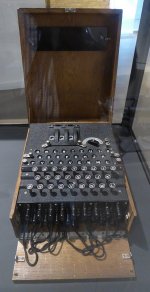Sorry, but perhaps I was too cryptic (pun intended) for you younger guys. I believe that the German Enigma machine as shown in the diorama had either three or four changeable rotors that were used in coding or decoding messages. The rotors were changed daily according to highly classified documents and had to be set in a predetermined pattern for the machine to work properly. It was not a simple task as the rotors had to be set perfectly and typing mistakes could not be tolerated.
Later machines, such as those used by the United States military, had five rotors and were installed in the radio room of most ships. Smaller craft, such as destroyers and destroyer escorts . . . the REAL Navy . . . were referred to as "small boys" among the fleet. You can imagine trying to set up the machine and decode messages while locked in a small compartment (perhaps four feet by five feet) with no ventilation while tossing and rolling in heavy seas. Hope this helps clarify my earlier post for the uninitiated.
Bosun Al; on active duty from 1956-1959
 IMG20200128145228 by Wayne Wayne, on Flickr
IMG20200128145228 by Wayne Wayne, on Flickr IMG20200128145210 by Wayne Wayne, on Flickr
IMG20200128145210 by Wayne Wayne, on Flickr IMG20200128145149 by Wayne Wayne, on Flickr
IMG20200128145149 by Wayne Wayne, on Flickr IMG20200128145136 by Wayne Wayne, on Flickr
IMG20200128145136 by Wayne Wayne, on Flickr IMG_20200128_145303 by Wayne Wayne, on Flickr
IMG_20200128_145303 by Wayne Wayne, on Flickr images by Wayne Wayne, on Flickr
images by Wayne Wayne, on Flickr


